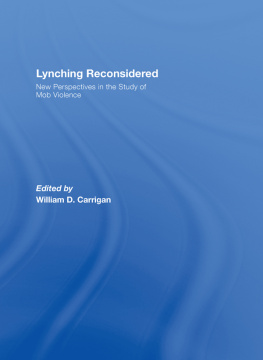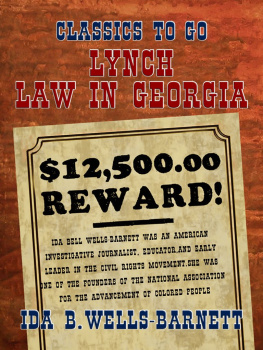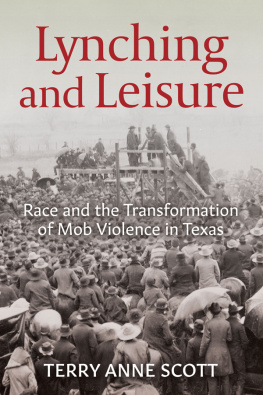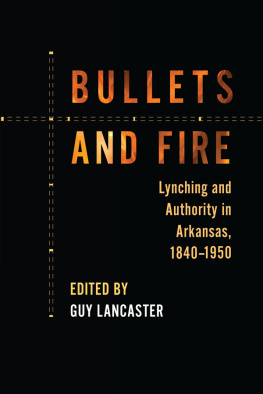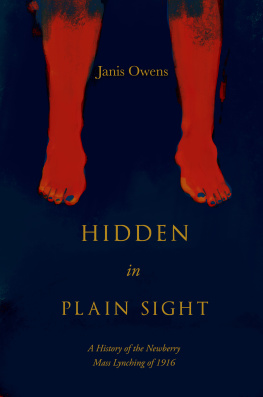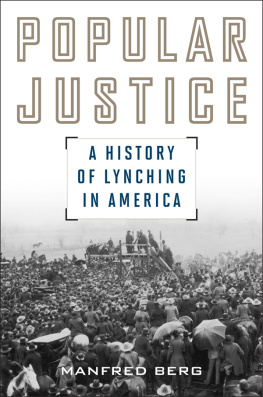Rope & Faggot
The African American Intellectual Heritage Series
Rope & Faggot
A Biography of Judge Lynch
with A New Introduction
by Kenneth Robert Janken
by
Walter White
UNIVERSITY OF NOTRE DAME PRESS
Notre Dame, Indiana
Copyright 1929 by Alfred A. Knopf, Inc.
Copyright 2001 by
University of Notre Dame
Notre Dame, Indiana 46556
All Rights Reserved
http://www.undpress.nd.edu
Manufactured in the United States of America
Library of Congress Cataloging-in-Publication Data
White, Walter Francis, 18931955.
Rope & faggot: a biography of Judge Lynch / by Walter White; introduction and bibliography by Kenneth Robert Janken.
p. cm. (African American intellectual heritage series)
Originally published: New York: Knopf, 1929.
Includes bibliographical references and index.
ISBN 0-268-04006-0 (cl. : alk. paper)
ISBN 0-268-04007-9 (pbk. : alk. paper)
1. LynchingUnited States. 2. African Americans. 3. United StatesRace relations. I. Title: Rope and faggot. II. Title. III. Series.
HV6457.W45 2001
364.1'34dc21
2001037600
ISBN 9780268096816
This book is printed on acid-free paper.
This e-Book was converted from the original source file by a third-party vendor. Readers who notice any formatting, textual, or readability issues are encouraged to contact the publisher at .
CONTENTS
to Walter White, Rope & Faggot: A Biography of Judge Lynch
Kenneth Robert Janken
by Walter White
CHAPTER ONE
The Mind of the Lyncher
CHAPTER TWO
The Extent of the Industry
CHAPTER THREE
Religion and Judge Lynch
CHAPTER FOUR
Sex and Lynching
CHAPTER FIVE
The Economic Foundations of Lynch-Law
CHAPTER SIX
Science, Nordicism, and Lynching
CHAPTER SEVEN
The Price of Lynching
CHAPTER EIGHT
The Changing Scene
CHAPTER NINE
Lynching and Laws: Is There a Way Out?
APPENDIX
A Statement of Fact
Kenneth Robert Janken
I n October 1926, Walter White, assistant secretary of the National Association for the Advancement of Colored People, author of two Harlem Renaissanceera novels, and courageous investigator of incidents of racial violence, broke the story of a triple lynching in Aiken, South Carolina. Bertha, Dedmon, and Clarence Lowman had been taken by more than thirty vigilantes from the jail where they were being held while on trial on trumped-up charges of the murder of a deputy sheriff. They were carried for more than a mile to the lynching spot, where more than one thousand spectators assembled to watch the murders. The assistant secretarys undercover inquiry exposed rampant official corruption, lawlessness, and rapid growth of the Ku Klux Klan. He forwarded to the states governor, who had publicly vowed to bring to justice those responsible, a partial list of mob members, including local law enforcement officials, politicians, prominent businessmen, and two of the governors relatives. The governor did nothing. White turned his findings and contacts over to the New York World, which sent its star reporter to Aiken and ran a multipart expos that received national attention. Aiken was the light-complexioned Whites forty-first incognito lynching investigation in eight years; in that time he had also probed eight race riots. He returned to New York relieved to be back above the Smith and Wesson line, as he called the Mason-Dixon. He was also drained by the experience and decided to take a leave of absence from the NAACP to pursue writing.
Having written the critically acclaimed Fire in the Flint (1924) and then Flight (1926), White wanted to try his hand at book-length nonfiction. The assistant secretary applied for and received a year-long Guggenheim Foundation fellowship to move to France and write, among other works, his anti-lynching treatise, Rope and Faggot. The grant was to commence in April 1927, but White arranged a later start to allow his wife Gladys time to recuperate from the anticipated birth of their second child (a boy, Walter Carl Darrow, to complement their daughter Jane) in June. On 23 July Walter White, en famille, boarded the Cunard lines Carmania, bound for Havre. With the $2,500 Guggenheim stipend supplemented by three months paid leave from the association, the Whites settled in Villefranche-sur-Mer in suburban Nice, in a white stone villa on a hill overlooking the Mediterranean. A Bon March grocery and Galleries Lafayette department store were twenty minutes away by tram. It was a bargain at the equivalent of fifty American dollars monthly. The Whites remained in Villefranche for six months, but when the tourist season made the Cte dAzur too expensive, the White mnage relocated to Avignon. Here White felt he could keep in touch with the Anglophone authorshe kept company with Ford Maddox Ford and Somerset Maughamwhile sampling a part of France that was not overrun with vacationing Americans and Brits or refugees from Mussolinis Italy. In both places he worked steadily on Rope and Faggot.1
Subtitled A Biography of Judge Lynch, Rope and Faggot is an outstanding example of partisan scholarship. It is based upon Whites firsthand investigations and a sampling of the relevant social scientific literature. The volume fulfilled two interrelated goals: it debunked Southern whites big lie that lynching punished black men for raping white women and protected the purity of the flower of the white race, and it delivered a penetrating critique of the Southern culture that nourished this blood sport. In the tradition of Ida B. Wells-Barnett at the turn of the twentieth century, White marshaled statistics demonstrating that accusations of rape or attempted rape accounted for less than 30 percent of lynchings. In those cases where the lynch victim did have sexual contact with a white female, White cast doubt on the veracity of the accusers. The assistant secretary identified four categories of girls or women likely to scream rape: adolescents who were grappling with their nascent sexuality; middle-aged women, who, he implied, were open to sexual experimentation; wives trapped in long-term marriages to unattractive men; and spinsters, who, again, he conjectured, sought some outlet for their sexual expression.2 Brandishing evidence of white females of all classes crossing the color line for loveevidence that white supremacists themselves broadcast in order to agitate whites to support anti-miscegenation lawsWhite insisted that most interracial liaisons were consensual and not forced.
How to account for the fury and sadism with which the mob attacked lynch victims? Despite the popular notion that whites held darker peoples repugnant and repulsive, white Southern males since the time of slavery had been attracted to black females. Through rape or concubinage, white men had taken advantage of black females, although to justify their aggression they impugned them by claiming that black women were naturally licentious.3 The lynchers savagery, including castration, was born of the unarticulated suspicion that, despite protestations to the contrary, sexual attraction across the color line ran more than one way, and the absence of repulsion applies to both sexes of both races (67). Through the act of lynching, the mobbist was projecting his own guilt about his sexual licentiousness on a black scapegoat and also intimidating white women who might find black men attractive (6668).4 But, White again emphasized, the usual crime was not normally the stimulus for the formation of the mob, although the cry of rape still circulated with alarming frequency because of whites obsession with sex. At bottom, White asserted, whites employed lynching to keep blacks in their place and, more specifically, as a way to control the black labor force (7677).


